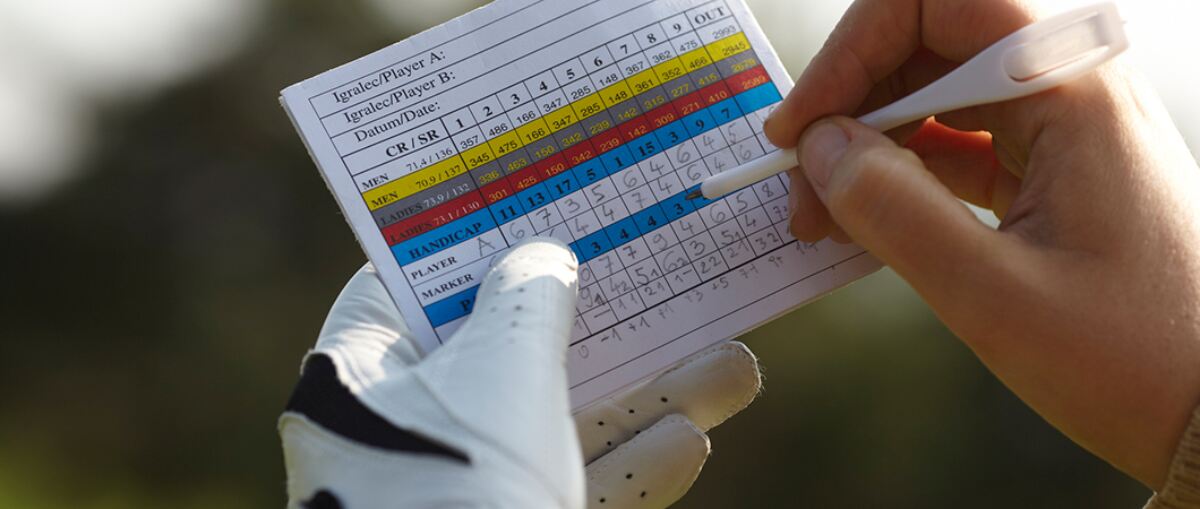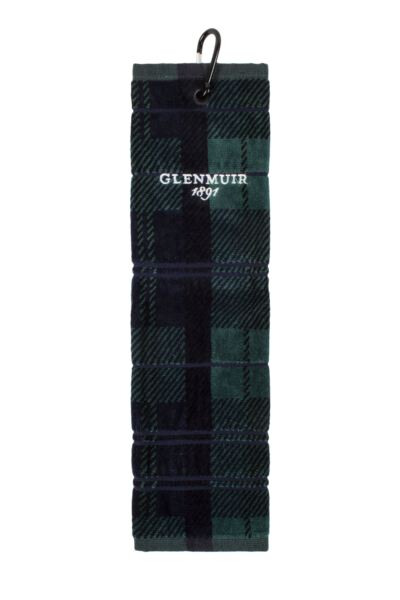Table of Contents
- Golf handicaps explained
- Why does the golf handicap system exist?
- Why you should consider a handicap on the golf course
- The pros and cons of a good handicap
- How the new World Handicap System works out a handicap
- Important Handicap System terms you need to know
- How to improve your golf handicap
- Glenmuir takes care of your golfing needs so you can focus on bringing your winning game
- FAQs
- Final thoughts
In amateur golf, a golf handicap provides the opportunity to play against another player or set of players and have a reasonable chance of winning - regardless of their skill level.
Yes, really; golfers of all abilities can play each other equally.
Although this might sound very straightforward, the bad news is that it isn't quite as easy a concept to fathom as you might think at first.
In this article, we will break down exactly what a golf handicap is, what it can mean for your game, as well as cutting through some of the technical jargon that you need to help make your golfing game that bit easier.
Golf handicaps explained
Although you want to play equally and fairly, do you ever feel intimidated or demotivated when your fellow players constantly outperform you in golf?
It's a common concern for many.
If that's the case, it's definitely time to consider a golf handicap number. With one of these, you will be on a level playing field, able to compete with players that are better than you and even have a decent chance of winning.
It's a system designed to be both fair and equal, allowing golfers of all abilities to play together and have fun while doing so by using a mathematical system.
As previously touched on, an amateur golfer can benefit from using the golf world handicap system when playing golf against other players, regardless of their golfing skill level and on any course - and even potentially win!
But how exactly?
A player's handicap is the total number of additional shots over par they are expected to take on the golf course. Handicaps are a great indicator of how good a player is; those with a low golf handicap won't have as many additional strokes to take on the course, whereas someone with a high golf handicap will be allowed more of these additional shots to complete the game.
Let's look at this in a bit more detail below.
Low golf handicap example
Imagine the scenario: You have a 7 handicap, and you are considered quite the adequate amateur golfer because of this.
But what exactly does this mean?
Well, say you were playing on St Andrews Old Course, which has a total course par of 72, you would be predicted to hit 79 strokes during this round of golf to complete the game.
Generally speaking, you would be expected to be, on average, 7 over par during a game.
However, as any golfer will tell you, that won't always be possible - some days could reveal even better results, while other days... well, let's not go there!
High golf handicap example
Why does the golf handicap system exist?
While a golf handicap is a brilliant indicator of how well an amateur golfer plays, it isn't its primary purpose.
Imagine you have a weekly game of golf with your friend. But, there's always a downside to these games; they beat you every, single time - and not just by a little bit either. They smash a drive off the range landing 300 yards away and putt with perfect precision each and every game.
Meanwhile, you're just not in the same league. Your putts are shabby, at best, and it seems like no matter what you do, you'll just never be able to win a game against your golf buddy fairly.
It's not going to make for much fun, is it? Playing head-to-head against them would mean you would lose each game.
But, with a course handicap in place, you can level the odds, making the game much more enjoyable, less intense and totally stress-free.
Say you take a number of shots even to make it to the green while Mr Golf-buddy-extraordinaire beside you takes just one; a course handicap will allow for this, essentially allowing you some free extra shots to level the game and get to the same point they are at.
At the end of the game, your course handicap amount is taken away from the number of strokes completing the game took you.
Why you should consider a handicap on the golf course
There are a variety of reasons why you should think about using a handicap at an amateur level.
These include:
- Learning your potential: Many people believe they are good at good and proudly tell the world of their prowess on the green, but believing in anything doesn't exactly make it true! With the measure of a handicap, the average golfer is able to confirm how good they are and, just as importantly, where they need to improve.
- Increasing the fun: Golf is meant to be enjoyable, not a torture method, and little demotivates players more than when they know they don't stand a chance of winning or even coming anywhere close! Only a golf handicap will level the playing field and create and much freer, more fun game.
- A difficult course is no longer an excuse: Because the course handicap is the golfer's index simply amended to the difficulty of the course, players can no longer blame a tough round on the difficulty of the course he just played.
- An official handicap is great to show off: Who doesn't enjoy boasting a bit when it's warranted? With a good handicap, you have measurable results that you can use to show off! The lower the score, the better, remember, and it'll only get better with time, patience and practice, giving you even more to boast about further down the line.
- It's good for a flutter: It's no secret that many golfers love a good bet, and a handicap allows players to do it without the risk of falling out over contextual and abstract matters, instead of focusing on the conditions allowing a fair and equal game.
- Finally, you will be able to provide an answer to the question: What is your golf handicap?: It is usually the very first question some asks when you tell them you play golf. Well, now you can answer it proudly, or maybe not, depending on how well your performance has been going!
The pros and cons of a good handicap
Now we know the benefits of having a handicap in the first place, the next question must be asked: what are the benefits of having a good handicap?
Well, for one, if you have a single-digit handicap, you can pat yourself on the back. You are considered to be a great golfer, and far better than average which is a great thing when you are informing people about your golfing game.
It lets potential players know what they could be up against when you face off on the green, and a score below 10 can boost your confidence too.
However, if you can't play to this handicap and your golf balls go astray more times than you would like to count, then having it isn't worth much. With a low handicap, there is very little margin for error, so you will have to be on your A-Game to stand a chance of beating your opponent in many cases.
But, if your handicap accurately reflects your number of strokes as well as your skill as an amateur golfer, then there isn't going to be too much of an issue!
How the new World Handicap System works out a handicap
In 2020, the golfing world was set for a big change when it was announced that the new World Handicap System was about to streamline the handicap rules across the world. It was hoped this would encourage new players to the golfing world.
This World Handicap System is now implemented across the globe to allow golfers to measure their skill level against any other player and in any course in the world.
The World Handicap System consists of two main components:
- The Rules of Handicapping
- The Course Rating System
Below we will discuss what these mean and how these affect a handicap score.
Important Handicap System terms you need to know
There are a few key terms that are important when it comes to the world handicap system, which we will explain below.
The handicap index
The golfer's handicap index is a measurement of their playing ability which is based on the previous scores used to make up your handicap.
The handicap index starts at 1 and continues up to 54, with the average male handicap index being 14.2.
Just to eliminate any confusion; a handicap and a handicap index are NOT THE SAME THING! A handicap is a player's total average number of strokes they are expected to hit on a golf club course over par, which is not what a handicap index is.
How is handicap index calculated?
There are two different ways the handicap index is calculated depending on whether you are a golfing newbie or an already existing player.
When it comes to new players, after playing three full rounds and therefore having successfully navigated 54 holes, you'll be given an initial handicap index.
If you have been in the game for a little longer, for your handicap index, you are required to produce the 8 best scores out of your last 20 registered scores. These scores will then be averaged, and this figure will be used to calculate your handicap index.
Scratch golfer
Bogey golfer
Slope rating
Any golfer will tell you that golf courses can vary wildly in their difficulty, so this system will take into account the difficulty of the course when calculating golf handicaps.
Course rating system
Par
How to improve your golf handicap
Cope with the pressure
Practice
Here are a few quick ideas that you can implement into your daily routine:
- Write a checklist of everything you want to practice.
- Facing a mirror, analyse both your alignment and grip.
- Have a quick go at chipping and putting.
Explore new golf courses
Don't be shy; put yourself out there! Continue to challenge yourself while evolving your game at a variety of different golf courses.
You probably play on one golf course most of the time. Try playing different golf courses to strengthen your game, as its challenges will be new. Before starting, it's a good idea to get on the putting green in order to become familiar with the speed in order to navigate the course handicap.
Glenmuir takes care of your golfing needs so you can focus on bringing your winning game
Since 1891, we at Glenmuir have been using their skill, knowledge and expert know-how to kit out golfers in the very best golfing clothes and accessories. We are a family-run business live who lives and breathes golf and everything golf-related.
For over 120 years, we have crafted only the best golfing attire, made from quality materials that are designed to go the distance. Today we are known globally as a world-leading resource for both amateur and professional golfers.
It's not just clothing we make; we have a huge range of accessories, including everything from golf balls and gloves to alignment markers and so much more. Just about anything golf-related you can think of, chances are we stock it!
Why not have a browse of our online store and see for yourself what we can bring to your golfing game?
FAQs
What's the average amateur golf handicap?
What figure would be considered a low handicap in golf?
What's the ideal golf handicap?
What's my handicap if I finish on 90?
In order to answer this, you need to be aware of the par for the golf course on which you are playing. Say the golf club you were playing at was a par 80, and you are continuously finishing on 90, then you would have a handicap of around 10.
While this sounds straightforward, with the new implementation of the WHS rules having been rolled out across the globe, you might find that your handicap can fluctuate based on what golf course you are playing.
Do I really need a golf handicap?
What is the maximum golf handicap?
With the introduction of new handicap rules from the new World Handicap System, the maximum handicap for both men and women is currently 54, whereas previously the maximum handicap was different for both sexes.
But - and it's a big but - a player's handicap does not have to equal the Handicap Index. A calculation is made based on the difficulty of a particular golf course and the Handicap Index in order to give a course handicap.
What's the average golf handicap?
Final thoughts
Allow it to be a measure of your performance; if you can play golf regularly, you are much more likely to get the most out of the game and, who knows, maybe even drive down your course handicap.
As the rules changed in 2022, bringing in a new system to calculate golf handicaps, this new way of framing the game of golf allows the rules around the world to be much more standard and, if it means players can take a few more shots at a difficult golf club, it definitely can't be a bad thing, right?
We hope this article has helped allow you to understand the fundamentals of the handicap system, the role of the World Handicap System, the benefits of uniforming the requirements across the world and well as learning how to calculate golf handicaps.
If you've managed to navigate your way through the sometimes complex world of the golf handicap and made it to the other side, you deserve a treat. See you on the 19th hole!




